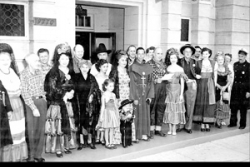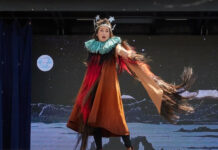
In 1951, Fiesta La Ballona emerged as a partnership between the City of Culver City and its Chamber of Commerce. It was designed as a weeklong celebration of Culver City’s early heritage. Culver City was carved from two ranchos, La Ballona and Rincón de los Bueyes.
The Fiesta offered something for everyone, from young to old, swimmers to dancers, and from descendants to recent arrivals. Evening events included an Aquacade in our newly opened “plunge,” happenings like a Teen Dance, Barbecue, a Square Dance, and a show onstage in our Veterans Memorial Auditorium. Centered around Veterans Memorial Building and Park, there was the Art Show, Garden Show, and even a Kiddie Parade, which showcased parents’ ingenuity with little red wagons, props and costumed kids. (Oh, how I hated the year I had to wear a mustache to pull my little brother and cousin.)
On the weekend, a community parade made its way from Higuera, (named for one of the owners of Rancho Rincón de los Bueyes), to Vets Park. Representatives from the Early Settler families, like Machado, Talamantes, Higuera, Lugo, Saenz, and Rocha, dressed their part to ride in vintage vehicles. (I was not crazy about the mantillas, either!) Some years they were horsedrawn buggies, while others offered a Model “A” or “T.”
Equestrians were greatly admired, and our Sheriff, Eugene Biscaluz, was a regular participant, just like the Pitti family. Floats ranged from decorated bicycles to trucks, and musical entries enhanced the celebratory atmosphere. There were marching units like bands, Scouts and other organizations added to the fun. The Chamber of Commerce even hosted the check-in point where Mustache Contest participants were photographed with their clean-shaven upper lips, in contrast to the contestants for Fiesta Queen and court at two age levels.
The early Fiestas were inclusive celebrations of family and local heritage. Participation was widespread. Everyone wanted to be an Indian (politically correct at the time), Ranchero, Señorita, Cowboy or Cowgirl! People dressed the part, participated in events, and grinned from ear to ear if they were picked up by “the Pokey.” (Fridays everyone dressed, even bank employees, or you got a ride in the Pokey!) ?Over time the August weeklong event changed to fit the times. It has been celebrated in May, was a “Festival of the People” for a short time, but no matter what month, or how many days the event, it remains a time to relax together, enjoy family, friends and community.
This year, the Fiesta runs from August 22-24. Enjoy your community and stop by the Culver City Historical Society Archives (noon to 4 p.m. Sat- urday and Sunday) to see a special exhibit from ‘the olden days,” -including dresses worn by the Fiesta Court.
Julie Lugo Cerra is the city historian. She has written five books.












